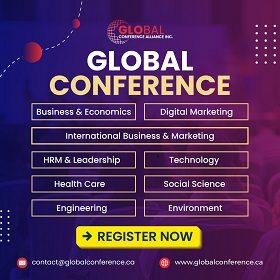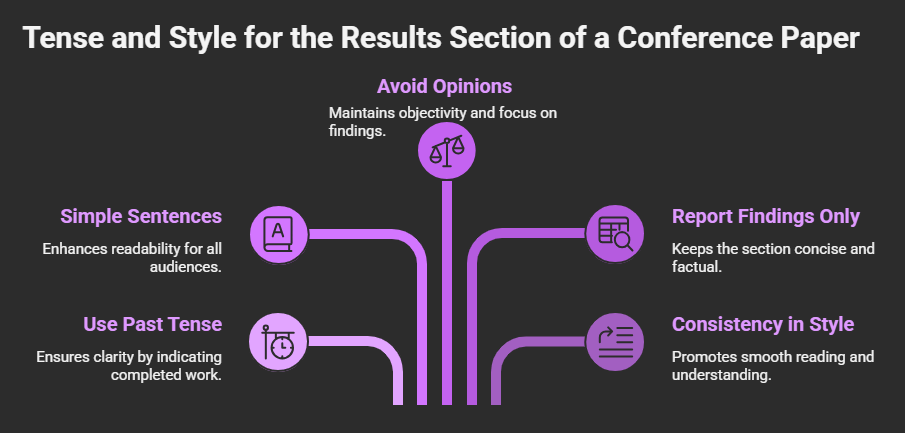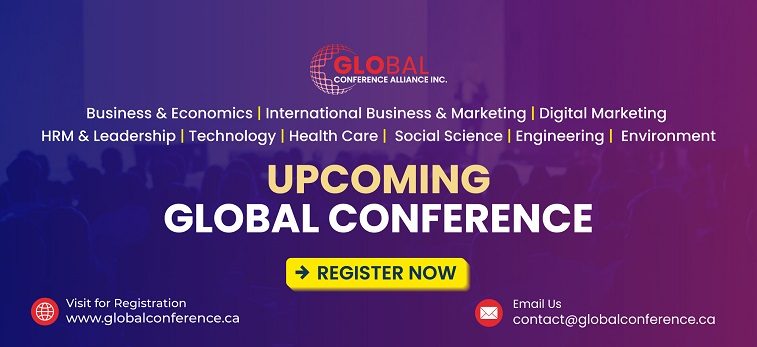Writing the results for a conference paper can feel like a big task, but it’s the part where your research gets to shine. You gather your findings, put your hard work together, and finally show everyone what you discovered. If you are wondering how to write results for conference paper?, You are not alone.
The best way to write the results section for a conference paper is to present your findings clearly and objectively, using short sentences, simple words, and helpful visuals like tables or graphs. Only include facts and numbers from your research, without adding personal opinions or explanations. Arrange the results in a logical order, and use clear headings, so readers can understand your main points quickly and easily.
Are you curious to learn more about organizing your results or want tips for handling unexpected outcomes? Keep reading this article, as you’ll find all the important details you need about writing results for conference papers in a simple and complete way.
How to Write Results for Conference Paper?
Writing the Results section for your conference paper helps readers see exactly what you found. This is where you show your data without explaining what it means. Some people find it tricky to keep things simple and organized. Keep reading to learn how to write this part clearly and easily.

Organize the Results
Putting your results in a logical order will help your readers understand your findings. You can arrange them based on your research questions or the order of your experiments. If you keep things organized, your results will be much easier to read. Always match the order you used in the earlier sections of your paper.
State Only Facts
All sentences in the Results section should only show facts and real numbers. If you’re preparing for international events like conferences in USA, Canada, or any other country, remember that your audience expects clear, honest data. Avoid adding reasons or guesses for your results. Leave your explanations for later sections in the paper.
Use Helpful Visuals
Graphs, tables, and charts are perfect for making your findings easy to see. You should always pick visuals that show your main points clearly. Place a simple explanation below each visual, so everyone understands it. Using good visuals can help your readers remember your main discoveries quickly.
Write Brief Sentences
It is a good idea to write short, easy sentences in this section. Readers will understand your findings better if they don’t have to read long paragraphs. Do not repeat any information, and only include facts that are important. Keeping things short and simple makes your results stronger.
Compare Data Clearly
You might have different groups or experiments that need to be compared. Place similar results together so people can see what is different or the same. Words like “however” or “also” make it easier to notice these points. Clear comparisons help everyone see what you learned.
Leave Out Opinions
Your own opinions and guesses should not be in the Results section. Only facts and findings from your research should be included here. The discussion section is the right place for your ideas and explanations. Keeping opinions out helps make your paper more trustworthy.
Make Everything Clear
Reread your results when you finish writing to check for mistakes or confusion. Try to say each point in a way that anyone can understand. Make sure your numbers match the tables and graphs you included. Simple, clear writing will always help readers learn from your research.
Writing your Results section well makes your whole paper stronger and easier to follow. Simple words and clear organization will help you get your points across quickly. If you keep checking your work, you can catch any mistakes before you finish. Always give yourself enough time to write this part carefully.
What Tense Should You Use When Writing the Results Section for Conference Paper?
Choosing the right tense and style is key when writing about your research results. This helps your readers clearly understand what you did and what you found. The way you write can make a big difference in sharing your discoveries. Keep reading for more helpful tips.
Using Past Tense
Most of the time, the past tense is best for the results section. This is because you are talking about what you already did and what you have already found. Using past tense makes it clear that your results are from your finished work, not ongoing work.
Simple and Clear Sentences
It’s best to use simple and clear sentences in this section. Avoid long or confusing words. Write in a way that is easy for everyone to understand. This helps make your results section strong and easy to follow, even for people new to the topic.
Avoiding Personal Opinions
In the results section, stay away from adding your personal thoughts or feelings. Stick to the facts and what the data shows. This keeps your writing honest and focused on the findings, not on what you think about them.
Reporting Only Findings
Remember to report only the findings in this part. Don’t explain why things happened or what they mean yet. Just describe what you observed or measured. Save all explanations or reasons for the discussion section that comes after.
Consistency in Style
Try to keep your writing style the same throughout the section. Use the same tense and the same type of sentences. This makes your results section smooth and easy to read. Consistency helps the reader move through your work without getting confused.
So, picking the right tense and writing style is key for the results section. This helps your readers understand your work better and keeps your writing clear. Follow these tips to share your research results with confidence!
Should You Use Tables, Figures, or Text for Presenting Results in Conference Papers?
When you want to show your results in a conference paper, you might wonder whether to use tables, figures, or just write things out in words. Picking the right way can help people understand your findings much better.
- Make It Visual: If you want your data to grab attention or show a trend, using a chart or a picture often works best and is easy to follow.
- Use Tables for Details: Whenever you have lots of numbers or specific information that people might want to look up, a simple table makes everything clear and tidy.
- Show Patterns with Graphs: Results that show patterns or changes over time are best displayed with a line graph or bar chart, making the information easy to understand at a glance
- Explain in Text for Simple Ideas: Clearly describe it in a few sentences if you only have a few main results or want to share an important point.
- Mix Methods Carefully: If you need to show both the big picture and the small details, using a mix of text, tables, and graphs together can help people see everything easily.
- Keep It Simple: Whether you choose words, tables, or charts, always make sure what you show is easy to read and not too crowded or confusing.
- Guide the Reader: Always mention in your text what to look at in your table or figure so people know exactly what to focus on and understand your point.
Picking the right way to share your results really matters. It helps everyone understand your work without getting lost or confused. Try to match your data with the best method, like tables, figures, or text. Keeping things simple and clear will always make your results stand out.
How Much Detail Is Enough in the Results Section of a Conference Paper?
Sometimes, writing the results section can seem confusing at first. It’s important to know how much detail is really enough to include. You do not want your results to feel too heavy or too light. Read on to see how you can strike the perfect balance.
Main Points First
Readers like to see the biggest and most important results before anything else. You can make your most important results easy to find and easy to understand. Make sure these results stand out so they do not get lost. This way, everyone knows what to focus on in your section. It makes your results section clear and saves readers time and effort.
Short, Simple Explanations
Explaining your results should not take too many words or sentences. Just say enough to make your findings easy to understand without any confusion. If something does not need a long explanation, keep it short and simple. Using short explanations helps everyone stay focused and not lose interest in your work.
Linking With Methods
Every result in your section connects back to how you did your research. It’s helpful to remember that the level of detail you include in your results often depends on how clearly you’ve outlined your approach in the methodology of a conference paper, ensuring consistency between what was planned and what was found.
Ignore Extra Data
Most readers will not need to see every single number or small finding. Leaving out data that does not support your main ideas can make your section stronger. Only add the results that help answer your main research questions. Unnecessary data just makes your results section harder to read and understand.
Tables and Figures
Charts, graphs, and tables make large amounts of data easy to see quickly. Showing results in a table or graph helps your readers understand your points faster and better. These tools also keep your writing neat and not too crowded with numbers. Tables and figures are a great way to make results easy to follow.
A results section with just the right detail is clear and easy to read. When you balance the details, your results are not too confusing. You help your readers understand what matters most in your work. Keep things simple, clear, and straight to the point.
How to Handle Negative or Unexpected Results in Conference Papers?
Negative or unexpected results are very common in research and experiments everywhere. Sometimes things do not work out the way you think they will. That does not mean your work is not important or useful. Keep reading to learn how to handle and share these results in the best way.
Stay Honest
Sometimes your results are not what you thought they would be at first. Sharing your real results makes your work trustworthy and helpful for others. It is always better to tell the truth instead of hiding anything important. Other people might also face the same things in their own work. Honest results help everyone learn from what you found. Never be afraid to share what really happened in your research or project.
Explain Clearly
People understand your work better when you explain exactly what you did. Talk about why you expected different results before you did your research. Describe what you planned, how you tested things, and what really happened. This helps others see your steps and your thinking process very easily. A clear explanation lets everyone learn from your experience in a simple way. Every detail you give makes your results easier to understand and remember.
Share the Value
Even if your results are not what you wanted, they can still help many people. You might have learned something important that you did not expect at all. Other people can use your experience to avoid mistakes or try new ideas. Sharing your findings helps others in their own research work. Your results can show a new way to look at a problem. No work is ever a waste, no matter what the outcome was.
Stay Calm and Positive
When you have results that surprise you, staying calm makes a big difference. Most people will respect your honesty and your hard work. If you feel nervous about presenting, remember you can always introduce in a conference presentation in a clear way. Calm words help others focus on your message, not just the results. Positive thinking makes sharing unexpected results much easier for you. It is a good way to show confidence in your work.
Suggest Next Steps
After you share your results, always talk about what could come next. Maybe you learned a better way to do your experiment in the future. Suggest some ideas for what to try or test next time. People will see you are thinking ahead and not giving up. Your next steps might help others solve the problem more quickly. Always keep moving forward with new ideas and better plans.
There is nothing wrong with having results you did not expect at first. Your research still has value and can help others learn. Honest sharing makes science and projects stronger for everyone. Remember, every result can help someone in the future.
Commonly Asked Questions
Want to know more about writing the results section for your conference paper? Here are some common questions and simple answers that can help you. These FAQs will make your writing process much easier. Let’s find out more together!
How Long Should the Results Section Be
The length of the results section depends on how much data you have to share. If your research has many findings, your results section can be a bit longer. It’s better to keep it clear and to the point, instead of making it very long. Always include enough facts, but avoid repeating information.
Can I Use Bullet Points in the Results
Yes, you can use bullet points if you want to list your main results. Bullet points make it easy for readers to find and remember important facts. Just make sure you don’t overuse them or make the section look too crowded. Use them only when you want to highlight a few key points.
Should I Include Raw Data in the Results
Raw data is not usually included in the main results section. Most people only want to see summaries, averages, or main numbers that matter. If you have a lot of raw data, you can add it to the appendix at the end. This way, the main section stays simple and clear.
Can I Use Headings in the Results Section
You can use headings to break up your results and make things clearer. Headings help organize your data into smaller parts, so readers can follow your work easily. Make each heading match a key point or topic in your results. This helps everyone see what each part of the section is about.
What If I Have Too Many Results
When you have too many results, focus only on the most important ones. You do not have to include every single number in the main section. Group your results to show patterns or trends, and use tables for extra information. Only share details that really matter for your research questions.
Is It Okay to Use the Same Results in More Than One Place
It’s best not to repeat the same results in different places in your paper. Repeating data can confuse your readers and make the section too long. If a result is very important, you can mention it again in the discussion section. Try to keep each result in its main spot for clear writing.
How Do I Write About Surprising Results
If you have surprising results, share them honestly in the results section. Just state what you found without giving reasons or guesses. Save your ideas and reasons for the discussion section later. Surprising results can be interesting for readers and are part of good research.
Can I Mention Problems or Errors in the Results
You can mention if you had problems, errors, or missing data during your research. Just state these issues simply and clearly, so readers understand your data better. Do not blame anyone or make excuses in this section. Always keep your writing honest and direct about what happened.
Should I Include Reference Numbers or Sources in Results
You do not need to add reference numbers or sources in the results section. This part is only about your own findings and data. If you want to talk about what others found, you can do that in the introduction or discussion section. Only include facts from your own research here.
How Can I Make My Results Easy to Remember
You can make your results easier to remember by using short sentences and simple words. Adding a strong visual, like a chart or graph, helps readers see your main points. Keep your writing organized and clear from start to finish. If you highlight your key results, people will remember them better.
Last Words
Writing results for your conference paper is about being clear, organized, and honest with what you found. Use simple words, arrange your data in a logical order, and add helpful visuals to make your points stand out. Always keep opinions out of the results section and only share the facts. Now you know how to write results for conference paper. Just keep it simple, true, and easy for everyone to follow.
Before you finish, remember to check for mistakes, use short sentences, and only include important details. Keep your data neat and easy to compare. With these tips, your paper will be strong and impressive. Best wishes as you share your results with confidence!







